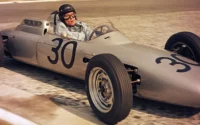Leyton House Racing raced in F1 during the 1990 and 1991 seasons. The team was essentially a continuation of the March team, which had re-entered Formula One in 1987. Leyton House, a Japanese real estate firm, initially became the team’s principal sponsor in 1987 and eventually purchased the team in 1989. Drivers Ivan Capelli and Maurício Gugelmin, who had been with March since 1987 and 1988, respectively, remained with the team following its rebranding as Leyton House Racing.
Notable Team Members and Drivers
Akira Akagi: The founder of Leyton House Racing and the owner of the Leyton House company, Akira Akagi, provided financial backing for the team through his business ventures in Japan, including the Leyton House design company.
Adrian Newey: One of the most influential Formula One engineers, Adrian Newey served as the technical director at Leyton House. Newey designed the Leyton House CG901, which is considered one of his early successes despite the team’s struggles on the track.
Ivan Capelli: An Italian driver, Capelli was the lead driver for Leyton House. He came close to winning the team’s race at the 1990 French Grand Prix.
Gustav Brunner: After Newey left the team in 1990, Brunner took over as the chief designer.
Background
During the mid-1980s, Leyton House was active in various motorsport series. The team faced tragedy when driver Akira Hagiwara died during a test session for a Mercedes touring car at Sportsland Sugo. Following the incident, team founder Akira Akagi encountered Ivan Capelli’s manager at an F3000 race in Imola. Capelli was signed on to replace Hagiwara in the 1986 Japanese Formula Two Championship under the condition that he could retain a substantial portion of the prize money to support his racing career in Europe. Akagi generously gave Capelli more prize money than initially promised.
Akagi also secured a sponsorship for Capelli to compete in the 1986 International Formula 3000 Championship with Genoa Racing, driving a March chassis. Capelli clinched the championship by a narrow margin of 2 points over Pierluigi Martini.
In 1987, although Akagi offered Capelli a full-time seat for another Formula Two season in Japan, Capelli opted to pursue a career in Formula 1. Subsequently, Akagi negotiated a title sponsorship deal with March Engineering, allowing March’s re-entry into Formula One in 1987 with a car designed for Capelli, as the Leyton House March Racing Team.
The March team struggled for competitiveness in 1987. In the following year, they hired Adrian Newey as a designer and brought on Maurício Gugelmin to partner with Capelli. The 1988 car showed significant improvement, marking the first time a naturally aspirated car had led a Grand Prix since 1983. Capelli secured two podium finishes, and the team finished sixth in the World Constructors’ Championship with 22 points.
In 1989, Akagi purchased March’s Formula One and F3000 operations. The team raced under the March name for that season, renaming their car the March CG891 in memory of Capelli’s manager, Cesare Gariboldi, who had died in a car accident. Despite an early podium for Gugelmin, the car was plagued with reliability issues throughout the season.
1990 Formula 1 Season
In the 1990 Formula One season, the team underwent a rebranding to become Leyton House Racing and expanded its staff from 19 people in 1987 to 120. Both drivers and Adrian Newey, now the technical director, were retained.
The team faced challenges with their CG901 car, which had several aerodynamic flaws due to inaccurate data from their wind tunnel. This led to the car failing to qualify in many of the initial races, with both cars only making it through qualifying in two of the first six rounds. These design issues eventually resulted in Newey’s dismissal during the summer.
During the 1990 Brazilian Grand Prix, team manager Ian Phillips was forced to take a leave of absence after contracting meningitis. With Phillips absent, control of the team temporarily passed to the team’s accountant, Simon Keeble. After a disagreement with Keeble, Newey left the team to join Williams, and Gustav Brunner replaced him.
Mid-season, a revised B-spec chassis was introduced to address the initial design’s faults. This updated model showed substantial improvements, notably at the 1990 French Grand Prix, where Capelli and Gugelmin led most of the race, largely due to strategic pit stops. Although Gugelmin retired due to a mechanical issue, Capelli finished second, overtaken by Alain Prost just a few laps before the end.
As the season concluded, many staff members who had come over from March left the team. Phillips returned at the 1990 Hungarian Grand Prix but departed at season’s end to join the Jordan team.
1991 Formula 1 Season
For the 1991 Formula One Season, Leyton House Racing transitioned from using Judd V8 engines to the new Ilmor V10 engines, partially financing the engine builder in the process. The design of the new Leyton House CG911 car was led by Gustav Brunner and Chris Murphy.
Unfortunately, the car proved less reliable than its predecessor. Ivan Capelli did not finish the first nine rounds of the championship, mainly due to mechanical failures. Maurício Gugelmin also faced challenges, completing only two of the first nine rounds. Capelli managed to secure the team’s only point of the season with a 6th-place finish at the 1991 Hungarian Grand Prix.
In September of that year, Akira Akagi was arrested over a financial scandal involving Fuji Bank, facing charges of fraud and money laundering. Following his arrest, Ken Marrable, an associate of Akagi, assumed control of the team, but the team’s financial resources rapidly dwindled.
With just two races left in the season, Capelli resigned from his driving position to join Ferrari for 1992, making room for pay-driver Karl Wendlinger to join the team and bring in some crucial funding. Capelli continued with the team in an advisory capacity, attending the remaining races at his own expense.
As the season concluded and the team faced upheaval, Gugelmin departed to join Jordan for the following season.
Leyton House Racing Legacy
The team was acquired by a consortium that included Marrable, Brunner, attorney John Byfield, and Dutch motorsport businessman Henny Vollenberg. In the 1992 season, the team reverted to the March name, likely as a strategy to dissociate from the controversies surrounding Akagi and the Leyton House company. Karl Wendlinger continued with the team, joined by Paul Belmondo; the Austrian driver secured a fourth-place finish at the 1992 Canadian Grand Prix, but financial challenges persisted, leading to Belmondo being replaced by Emanuele Naspetti and Wendlinger stepping aside for Jan Lammers, a friend of Vollenberg, who was making a comeback to F1 after ten years.
Efforts to sell the team in the winter of 1992 were unsuccessful. Although Lammers and Jean-Marc Gounon were announced as drivers for the 1993 season, funding issues led to the team folding in early 1993.
Akira Akagi, the founder of Leyton House, passed away on August 8, 2018.
Leyton House Racing Formula One World Championship Records
| First entry | 1990 United States Grand Prix |
|---|---|
| Races entered | 32 |
| Constructors’ Championships | 0 |
| Drivers’ Championships | 0 |
| Race victories | 0 (best finish: 2nd, 1990 French Grand Prix) |
| Pole positions | 0 (best grid position: 7th, 1990 French Grand Prix and 1991 Portuguese Grand Prix) |
| Fastest laps | 0 |
| Final entry | 1991 Australian Grand Prix |
Leyton House Racing Constructors’ Championship Results
| Year | Name | Car | Drivers | Points | WCC |
|---|---|---|---|---|---|
| 1990 | Leyton House Racing | CG901 | Maurício Gugelmin Ivan Capelli | 7 | 7th |
| 1991 | Leyton House Racing | CG911 | Maurício Gugelmin Ivan Capelli Karl Wendlinger | 1 | 12th |
Source: Wikipedia.com

